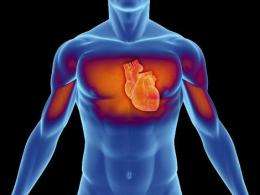Protein switch controls how stem cells turn into new heart tissue

(Medical Xpress) -- Oxford University researchers have identified a protein that can direct stem cells to become either new heart muscle or blood vessels.
The research, which was carried out in zebrafish, offers insight into how it might be possible one day to generate tissues to repair the human heart after damage inflicted by a heart attack.
The scientists, based at the MRC Molecular Haematology Unit at the University of Oxford, identified a protein called ‘fibroblast growth factor’ (Fgf) as the controlling factor which determines whether developing heart cells become heart muscle or blood vessels.
They showed that manipulating levels of Fgf in zebrafish embryos could determine how much of each cell type was made.
The research, funded by the Medical Research Council and British Heart Foundation, is published in the journal Development.
Dr. Filipa Simoes, one of the first authors of the study, said: "Our study shows how having the correct concentrations of Fgf in the developing zebrafish heart ensures that the different cell types form properly.
"Crucially, we were able to convert blood and blood vessel cells into heart muscle cells by flipping genetic switches controlled by Fgf. The important next step to this research will be to identify the relevant cells in the human heart and take this finding to the next level."
Professor Roger Patient, who led the research at the University of Oxford, explained: "If we can manipulate these heart cells in fish embryos, in the longer term we can look to try and do the same in human hearts – even adult hearts – if we can identify the equivalent cells. This could bring significant benefit to heart attack patients or people with heart defects."
Professor Patient adds that early-stage studies in the lab like this are crucial in turning the potential of stem cells into effective treatments that can help patients recover from heart attacks.
"At the very least, our research will help the production of these cells in the laboratory for use in heart repair. Mending a damaged heart requires new muscle and associated blood vessels. Therefore there is great interest in identifying and manipulating cells that make both."
The researchers also propose that these cells in the fish, with the potential to make both heart muscle and vessels, may represent cells which played an important role in evolution. Over millions of years they may have been responsible for an increase the amount of cardiac muscle, enabling the heart to grow in size from two chambers in the zebrafish to four chambers in humans.
Professor Jeremy Pearson, associate medical director at the British Heart Foundation, who co-funded the study, said: "This excellent study throws new light on how our four-chambered hearts evolved from the simpler structures we see in other animals. The results significantly increase our understanding of the origins of stem cells found in the adult heart. This provides important clues to researchers working towards the goal of mending broken hearts after heart attack."
















